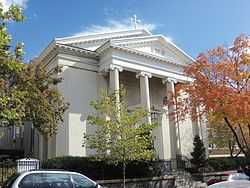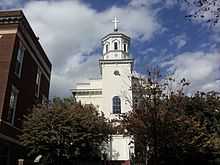Holy Trinity Catholic Church (Washington, D.C.)
| Holy Trinity Catholic Church | |
|---|---|
| Ecclesia Catholica Sanctae Trinitatis | |
 | |
| 38°54′25″N 77°04′13″W / 38.907°N 77.0703°WCoordinates: 38°54′25″N 77°04′13″W / 38.907°N 77.0703°W | |
| Location |
1301 36th St NW (St. Ignatius) 3513 'N' Street NW (Holy Trinity) Washington, D.C. |
| Country | USA |
| Denomination | Roman Catholic |
| Website |
www |
| Architecture | |
| Status | Active |
| Functional status | Parish church |
| Architect(s) | Kerns Group Architects (St. Ignatius)[1] |
| Years built |
1787 (renamed Chapel of St. Ignatius) 1849 (present building) |
| Administration | |
| Parish | Holy Trinity |
| Archdiocese | Washington |
| Province | Washington |
| Clergy | |
| Vicar(s) | Fr. William Ryan, SJ |
| Pastor(s) | Fr. Mark Horak, SJ |
| Laity | |
| Director of music | Dr. Kathleen DeJardin |
| Organist(s) | Tim Duhr |

Holy Trinity Catholic Church is a Catholic church located in Washington, D.C., in the United States. Located in the Georgetown neighborhood, it was established in 1787 and finished construction in 1794 and is the oldest Roman Catholic house of worship in both Georgetown and the larger city of Washington, D.C. The original building was vacated due to the lack of space and is now the Chapel of St. Ignatius, which is used as an auxiliary space for parish activities.
History of the church
Holy Trinity Church was established in 1787 at which is now 3513 N Street NW.[2] It was founded by Archbishop John Carroll, the first Catholic bishop in America and a cousin of Charles Carroll, a signer of the Declaration of Independence. This church faced south and included a bell tower. During the early years it primarily served the growing Catholic population of Georgetown and the students of Georgetown College (now University).[3]
The congregation soon outgrew its original building, and in 1829 a larger structure was erected at 1301 36th Street NW. This structure faced west, and did not include a tower. The first church was retained and renamed the Chapel of St. Ignatius. During the American Civil War, the US government used the church as a hospital to treat more than 200 injured soldiers after the Second Battle of Bull Run in 1862. The government returned the building to the congregation in 1863 and later reimbursed them $350 for use of the building.[4]
Holy Trinity Church established a parochial school for boys in 1818. It originally occupied a house on N Street east of the original church, but in 1818 the church built a schoolhouse at the northwest corner of N and 35th Streets NW. Holy Trinity School served grades one through eight. The school closed in 1829, but reopened in 1831. Holy Trinity Church remodeled its original church structure into a school in 1871, and moved classes into the structure. The church built two school buildings in 1918: The "Lower School" at the northeast corner of N and 36th Streets NW, and the "Upper School" at the southeast corner of O and 36th Streets NW. Students were delayed in using the Lower School, however, when the federal government requisitioned the building for use during World War I. The building was finally occupied as a schoolhouse in 1919.
President John F. Kennedy and his family frequently worshiped at Holy Trinity.[5] Kennedy's attendance is commemorated by a plaque in front of the church building.
From its inception, the parish has been administered by the Jesuits.
Cemetery
Holy Trinity Church cemetery of 1787
A cemetery originally occupied what is now the site of the 1829 church and the Lower School.[2] This informal burying ground was established long before Holy Trinity Church bought its land.[6] In June 1796, an additional 20 feet (6.1 m) of land west of the church was purchased, and by 1798 the church owned all the ground west to 36th Street.[7] Many of the graves were relocated in 1817 when the burying ground closed, but by as late as 1917 (when Lower School was built) hundreds of them still remained.[8] Over time, nearly all of the remaining headstones and memorial markers were removed.[2]
In 1998, Holy Trinity Church began construction on an addition to the original church in what was believed to be open space on its land. On October 21, a skull and some small bones were unearthed.[9] District of Columbia law required that a forensic anthropological investigation occur, and one began immediately. The investigation turned up the remains of 44 individuals (men, women, and children). Evidence indicated that some of these remains had been buried as early as 1837 while others dated to 1865, and at least one set of remains belonged to an African American. These remains were removed and reinterred in another cemetery. Archeologists believed, however, that additional remains still existed. But with each day of delay adding $10,000 to the cost of construction, Holy Trinity Church officials determined that graves which would be undisturbed by the construction project—such as those buried beneath the basement, or those which would not be disturbed by construction—should remain where they are.[2]
College Ground
In 1818, Holy Trinity Church established a new burying ground on the north side of P Street NW at its intersection with 37th Street NW, adjacent to what is now Georgetown University's Maguire Hall. This cemetery was known as Trinity Burial Ground and the Old Burying Ground, but it was most commonly called College Ground.[10] The first burial occurred there on December 8, 1818. At some point, a small chapel dedicated to St. Francis Xavier was also built there. One of the most famous burials at College Ground was that of Susan Decatur, wife of United States Navy hero Stephen Decatur.[2] In 1837, Susan Decatur donated $7,000 to Georgetown University (equivalent to more than $3 million today), which saved the university from financial collapse and closure.[11] A large number of African slaves, many of them owned by institutions (such as the university), were also buried in College Ground.[2]
Based on parish records, the number of graves at College Ground numbered more than 1,000 by 1833, when burials there ceased.[2] The cemetery fell into disrepair, with many tombstones and memorials destroyed, removed, or dislocated and placed off to one side. There was so little evidence that College Ground once existed that by the early 1930s the land was thought to be vacant. In 1931, Georgetown University began construction on a new dormitory, Copley Hall. When workers began clearing a "vacant lot" 100 feet (30 m) north of the Copley Hall excavation site, they rediscovered College Ground. Embarrassed by its sub-par stewardship of the graveyard, the university agreed to restore and care for the burying ground. But within 20 years, the college's need for land proved greater than its commitment to the cemetery.[12]
In 1953, Georgetown University cleared College Ground of remains and began preparing the area for the construction of new buildings. The university publicly said that only 189 remains existed at College Ground.[13] Fifty remains were transferred to Mount Olivet Cemetery,[2] while most of the others were transferred to Holy Trinity Church's Holy Rood Cemetery.[12] (A few remains were claimed by families, while a handful of others were reinterred in other cemeteries). Historian Carlton Fletcher believes that the 850 or so remaining bodies in College Ground either are still buried there, or were dug up and scattered when the Reiss Science Building (1962) and Edward B. Bunn S.J. Intercultural Center (1982) were excavated.[2]
Holy Rood Cemetery
College Ground closed to new burials because Holy Trinity Church acquired a new, larger burying ground in 1832: Holy Rood Cemetery.[2] Originally called the Upper Grave Yard, this cemetery was at the southern terminus of Tunlaw Road NW. It was enlarged in 1853, and a sexton's house constructed at the entrance.[14] The grounds were enlarged again in 1866 and 1867 (to its present size of 6 acres (24,000 m2)), a new sexton's house built, a receiving vault constructed, and a stone wall and new main gate erected on Wisconsin Avenue NW. It was at this time that Upper Grave Yard received the name Holy Rood Cemetery.[15] Under an agreement with the Roman Catholic Archdiocese of Baltimore in which Holy Trinity Churche's many deeds were consolidated, Georgetown University has held title to Holy Rood Cemetery since 1942.[12] The university closed the cemetery to new burials in 1984 (except for special requests). There are 7,312 known burials there, as well as an unknown number of unidentified pauper's graves.[2] The university attempted to move all remains and use the cemetery for real estate development in 1984, but was stopped after a successful lawsuit by the survivors of people buried there. The university subsequently agreed to keep the cemetery open to visitors. While it abandoned "perpetual care" (the highest degree of maintenance for a cemetery), it agreed to continue minimal mowing, weeding, and other landscaping needs.[12][16]
Since the 1942 agreement, Holy Trinity Church has not maintained a cemetery for parish use. Parishioners rely instead on archdiocesan cemeteries in the area, such as Mount Olivet Cemetery in D.C. or Gate of Heaven Cemetery in Silver Spring, Maryland.
See also
- Holy Trinity Church
- Roman Catholic Archdiocese of Washington
References
- ↑ "Portfolio — Worship — Holy Trinity". kernsgroup.com.
- ↑ 2.0 2.1 2.2 2.3 2.4 2.5 2.6 2.7 2.8 2.9 2.10 Fletcher, Carlton (July–September 2002). "Burial Grounds of Holy Trinity Church, Georgetown, D.C.". Newsletter of the Catholic Historical Society of Washington.
- ↑ Chapel of St. Ignatius of Loyola
- ↑ "History Trinity". holytrinitydc.org. Retrieved October 26, 2010.
- ↑ America's Church: The National Shrine and Catholic Presence in the Nation's Capital. Oxford University Press. 2011. p. 188. ISBN 9780199782987.
- ↑ Warner 1994, p. 3, 234 fn. 1 and fn. 2.
- ↑ Kelly 1945, p. 17, 78.
- ↑ Kelly 1945, p. 112.
- ↑ "The Washington Post". October 22, 1998.
- ↑ "Cemetery Yields Forgotten Graves at Georgetown U.". The Washington Star. January 24, 1931; "The Washington Herald". January 25, 1931.
- ↑ Curran 1993, pp. 117-118.
- ↑ 12.0 12.1 12.2 12.3 Brint, Juliana (October 29, 2009). "Six Feet Under GU". The Georgetown Voice. Retrieved May 17, 2014.
- ↑ "GU to Transfer Ancient Graves". The Washington Post. April 17, 1953.
- ↑ Kelly 1945, pp. 112-113.
- ↑ Warner 1994, p. 74.
- ↑ "GU to Close Cemetery". The Washington Post. November 11, 1984.
Bibliography
- Curran, Robert Emmett (1993). From Academy to University, 1789-1889. Washington, D.C.: Georgetown University Press. ISBN 9780878404858.
- Kelly, Laurence J. (1945). The History of Holy Trinity Parish, Washington D.C., 1795-1945. Baltimore, Md.: John D. Lucas Printing Company.
- Warner, William W. (1994). At Peace With All Their Neighbors: Catholics and Catholicism in the National Capital, 1787-1960. Washington, D.C.: Georgetown University Press.